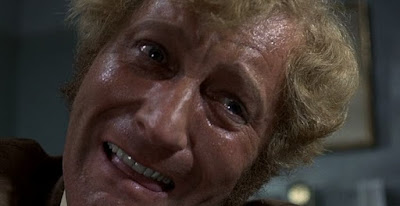THE BRIDES OF DRACULA (1960)
DRACULA, PRINCE OF DARKNESS (1966)
DRACULA, PRINCE OF DARKNESS (1966)
"Say you forgive me for letting him love me";
Andree Melly is one of THE BRIDES OF DRACULA.
Andree Melly is one of THE BRIDES OF DRACULA.
DIRECTOR Terence Fisher's reputation rests almost entirely on the horror films he directed for Hammer in the 50s and 60s, but he was a more versatile filmmaker than this output suggests. Fisher had previously helmed projects with a variety of themes - such as tragic romance and light comedy - but he was accused of representing a conservative and pedantic force within British horror. Yet within his construction a primal yet supremely visual ethos was created, mixing precise framing and acting with negligee-wearing vampire brides and claustrophobic burial vaults. In fact, Fisher epitomised Andrew Sarris' definition of the auteur in The American Cinema: Directors and Directions 1929-1968 "…to evoke a self-contained world with its own laws and landscapes." Above all, Fisher was a storyteller, preserving the coherence of his films by containing few flashbacks and virtually no dream sequences.
Fisher's THE BRIDES OF DRACULA begins with Marianne (Yvonne Monlaur) - en route to a teaching engagement - taking shelter at the invitation of Baroness Meinster (Marita Hunt). From her room's balcony, Marianne sees a young man chained by his ankle, Baron Meinster (David Peel), her hostess’ vampire son whom his mother has been acquiring peasant girls for feeding. After freeing the Baron without knowing of his past, the woman escapes into the woods where she is rescued by Dr Van Helsing (Peter Cushing), who must face the Seal of Dracula once more.
Despite a relatively late introduction, Peter Cushing effortlessly commands the screen in THE BRIDES OF DRACULA. The scene where Van Helsing proceeds to burn out his bite from Meinster with holy water and a red-hot branding iron is one of Hammer's most heart-rending.
Despite a relatively late introduction, Peter Cushing effortlessly commands the screen in THE BRIDES OF DRACULA. The scene where Van Helsing proceeds to burn out his bite from Meinster with holy water and a red-hot branding iron is one of Hammer's most heart-rending.
Despite a contradiction from DRACULA that vampires cannot change their form (though curiously unavailable to the Baron when held in leg irons), and the arrival of Hammer's customary unconvincing bat, THE BRIDES OF DRACULA is a sumptuous production. With the absence of Christopher Lee, the androgynous Peel makes for an engaging, Byronic, manipulative charmer in his role "to spread the cult and corrupt the world." Subsequent Lee/Dracula Hammers all de-vitalised rather than embodied The Count, and the followers of the vampire in THE BRIDES OF DRACULA are painted with a complex stroke that the series would not feature so successfully again; when the cackling Greta (Freda Jackson) - Meinster’s childhood nurse - lies full length on a freshly dug grave beckoning its occupant "I know it’s dark, but you’ve got to push, push…", no wonder Van Helsing is startled. Van Helsing demonstrated a cool but obsessive intensity in DRACULA, but his character changes substantially here; now a vampire slaying hero, much of his scientifically detached persona and harsher edges have been smoothed over. With Lee not taking centre stage, it is Cushing that must carry the film.
What is often overlooked with Lee's return in Fisher's DRACULA, PRINCE OF DARKNESS is that THE BRIDES OF DRACULA was the last film to feature Cushing until his modern day return in DRACULA A.D. 1972, although DRACULA, PRINCE OF DARKNESS does have a Van Helsing replacement, Andrew Keir’s warrior-monk Father Sandor. However, Lee's much-anticipated reprisal is reduced to a series of mute, melodramatic and repetitive attacks, and the two stand-out sequences don't feature The Count at all: the sacrifice of Alan (Charles Tingwell) and the controversial ecclesiastical gang rape of his wife Helen (Barbara Shelley). Such sequences, however, do subscribe to the poetry of flesh and blood akin to Bram Stoker's source material. The Count slipping through broken ice to be swallowed by the running waters of the moat around his castle makes for a powerful ending, with the scene seeming reminiscent of Dante’s Inferno, which shows Satan trapped in the ice in the lower pit of hell.
What is often overlooked with Lee's return in Fisher's DRACULA, PRINCE OF DARKNESS is that THE BRIDES OF DRACULA was the last film to feature Cushing until his modern day return in DRACULA A.D. 1972, although DRACULA, PRINCE OF DARKNESS does have a Van Helsing replacement, Andrew Keir’s warrior-monk Father Sandor. However, Lee's much-anticipated reprisal is reduced to a series of mute, melodramatic and repetitive attacks, and the two stand-out sequences don't feature The Count at all: the sacrifice of Alan (Charles Tingwell) and the controversial ecclesiastical gang rape of his wife Helen (Barbara Shelley). Such sequences, however, do subscribe to the poetry of flesh and blood akin to Bram Stoker's source material. The Count slipping through broken ice to be swallowed by the running waters of the moat around his castle makes for a powerful ending, with the scene seeming reminiscent of Dante’s Inferno, which shows Satan trapped in the ice in the lower pit of hell.
Barbara Shelley succumbs to DRACULA, PRINCE OF DARKNESS.
Whereas the economic retelling of Stoker’s novel in DRACULA left no room for the characters of Dr Seward and Renfield, a Renfield substitute appears in the guise of Ludwig (Thorley Walters). Here an obsessive but chivalrous bookbinder in the hospitality of a monastery, Ludwig is the one Renfield in cinema who actually encapsulates the character as Stoker describes him. Although partial to eating flies, Walters never radiates total madness, instead performing such transgression as mischief in an existence vague to everyone and thing except the needs of his Master.






